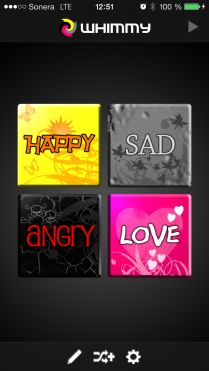DailyBean
LQ: 9.6
Recommended Age: 4+
Skills Used: Self-Awareness, Self-Control, Reading, Writing

Whimmy is a music app designed with users’ emotions in mind. On the home screen are four categories: sad, happy, angry, and love. Syncing either through Spotify or iTunes, Whimmy allows users to fill the categories with their favorite songs that match the described mood, allowing them to call upon music that fits their current state of mind. Since every song added to Whimmy is done manually, the emotionally-themed playlists created are highly personal, and can be used to help users control their emotions or augment their moods. It is a fairly one-dimensional app, but accomplishes what it sets out to do: have ready-made mood-influenced playlists to help users further explore a particular state of emotion. Assuming that parents monitor all content synced to their childrens’ Whimmy playlists, the app is suitable for children 6 and older.
Understanding our own actions, thoughts and feelings. Improving social skills.
 The crux of the self-awareness thinking skill is the ability to tune into one's own thoughts and feelings as well as the those of others. That process is made fun and easy with Whimmy's music curation features. As users' playlists begin to get more comprehensive, they will have a set of songs for the way they feel at any given point during the day. If users are feeling down, putting on a sad song does more than simply perpetuate the feeling. The song allows them to explore why they are sad, allowing them to pinpoint many of the the causes for their mood. Music can also alter the way a person feels. Users looking to lift their mood should start to compile more upbeat songs for their happy playlist. Changing the music to something more soothing and uplifting can help users to climb out of any funk they might be in. Whimmy can be both an emotional remedy and an exploratory tool.
The crux of the self-awareness thinking skill is the ability to tune into one's own thoughts and feelings as well as the those of others. That process is made fun and easy with Whimmy's music curation features. As users' playlists begin to get more comprehensive, they will have a set of songs for the way they feel at any given point during the day. If users are feeling down, putting on a sad song does more than simply perpetuate the feeling. The song allows them to explore why they are sad, allowing them to pinpoint many of the the causes for their mood. Music can also alter the way a person feels. Users looking to lift their mood should start to compile more upbeat songs for their happy playlist. Changing the music to something more soothing and uplifting can help users to climb out of any funk they might be in. Whimmy can be both an emotional remedy and an exploratory tool.
Managing our actions, feelings and behaviors.
Emotions are a tough thing to fully control - especially those that are more extreme like anger and despair. But music can actually help stave off poor moods and augment mood to help take control over emotions. In order for users to exercise more control over the impulsive behavior that often accompanies a mood swing, users should try to use their emotionally-themed playlists to help remedy their mood before it grows out of hand. Also, the sad and angry playlists can be filled with songs to battle those moods, such as using soothing soft music to calm down or choosing a song with a positive message to fight back the blues. Impulsivity is often a product of frustration. And if frustration can be lessened with a change in the style of music users listen to, then users are well on their way to becoming more in control of their own emotional states.
All membership plans come with full access to our entire suite of tools learning guides, and resources. Here are a few of the ones we think you’ll like the most: